Standard work on a Kiesel for my customers is total rewire and replace all the electrics.Kiesel certainly has their problems and the 2010 Carvin C66 and 2015 Kiesel Aries AM7 I own have some minor cosmetic issues but are built perfectly in areas that matter. Excellent fretwork on both.
I disagree about the Kiesel pickups, I find that the Kiesel Lithiums on my AM7 are great pickups but different from what many other brands do. They have some dip in the low mids and are extremely bright, but that also makes them remain clear even with high gain and makes the tone knob far more useful as there's a bigger usable range on it.
You are using an out of date browser. It may not display this or other websites correctly.
You should upgrade or use an alternative browser.
You should upgrade or use an alternative browser.
Andy Eagle ( Guitar repair tech for 30 years )
- Thread starter Eagle
- Start date
laxu
Rock Star
- Messages
- 8,372
Well, if they don't like them, they don't like them. And I can understand why they wouldn't, if they are the "volume and tone on 10" type player.Standard work on a Kiesel for my customers is total rewire and replace all the electrics.
Brash ceramic , lacking in warmth and texture.Well, if they don't like them, they don't like them. And I can understand why they wouldn't, if they are the "volume and tone on 10" type player.
They are far from volume / tone on ten players .
And I take the opportunity to swap out the Alpha pots and switch. It fairness these days the full size Alpha pots are fine but the switches have to go.
laxu
Rock Star
- Messages
- 8,372
Their current lineup has only like 4 purely ceramic pickups: https://www.kieselguitars.com/pickups None of them are the stock option afaik.Brash ceramic , lacking in warmth and texture.
They are far from volume / tone on ten players .
And I take the opportunity to swap out the Alpha pots and switch. It fairness these days the full size Alpha pots are fine but the switches have to go.
I think the old Carvin pickups had a far worse reputation but I don't have experience with those, the Carvin I have has had its pickups swapped for Suhr Doug Aldrich, which are my second favorite pickup after the Seymour Duncan Custom 5.
I've honestly had better experiences with Alpha pots than CTS for example for things like consistency to rated value, how logarithmic they are etc. CTS often doesn't do anything (no change in resistance) for like 1/4 of the knob's travel. Not sure if that's a "feature" on them or not. If it is, why?
SpaceMan
Groupie
- Messages
- 88
I'll be looking forward to this. These days it seems hard to get a genuine, quality evaluation of guitars - with all of the YouTube "reviewers" offering their "unbiased" opinions.I have a garbage in glitter category too but I will keep that for another day.
Yes starting with " Anything for a Dollar Darrel".I'll be looking forward to this. These days it seems hard to get a genuine, quality evaluation of guitars - with all of the YouTube "reviewers" offering their "unbiased" opinions.
CTS pots need to be cherry picked really. The sales model has many different tapers and specifications that are not necessarily as good as they should be for this application. If you buy 450 series with a 7% tolerance and measure to the heigh end of this a standard log taper is very good for mid to high gain and a custom taper for clean to break up. These are still a lot better than the most premium Alpha models. The Alpha mini pots are utterly crap though.Their current lineup has only like 4 purely ceramic pickups: https://www.kieselguitars.com/pickups None of them are the stock option afaik.
I think the old Carvin pickups had a far worse reputation but I don't have experience with those, the Carvin I have has had its pickups swapped for Suhr Doug Aldrich, which are my second favorite pickup after the Seymour Duncan Custom 5.
I've honestly had better experiences with Alpha pots than CTS for example for things like consistency to rated value, how logarithmic they are etc. CTS often doesn't do anything (no change in resistance) for like 1/4 of the knob's travel. Not sure if that's a "feature" on them or not. If it is, why?
Hi Eagle,
For the SOLE PURPOSE of getting a guitar’s action as low as possible, is the Zero Glide a good idea, or pointless?

What I am driving at, is if I had two identical guitars, one guitar with the nut cut to make the lowest possible action, and the other guitar with the Zero Glide, would the effect LITERALLY be the same?
OR, would the fact that ALL the strings resting on the Zero Glide fret would be of identical height (instead of seated in individual nut slots of barely different heights,) make a big difference?
I mean, if you can buy the Zero Glide fret with a radius identical to your fretboard (in my case, 12”,) I can see how POTENTIALLY you may be able to lower/improve the guitar’s action by some minuscule amount.
?
Your thoughts?
Thanks again for your time!!
For the SOLE PURPOSE of getting a guitar’s action as low as possible, is the Zero Glide a good idea, or pointless?
What I am driving at, is if I had two identical guitars, one guitar with the nut cut to make the lowest possible action, and the other guitar with the Zero Glide, would the effect LITERALLY be the same?
OR, would the fact that ALL the strings resting on the Zero Glide fret would be of identical height (instead of seated in individual nut slots of barely different heights,) make a big difference?
I mean, if you can buy the Zero Glide fret with a radius identical to your fretboard (in my case, 12”,) I can see how POTENTIALLY you may be able to lower/improve the guitar’s action by some minuscule amount.
?
Your thoughts?
Thanks again for your time!!
Yes, it seems like a bad solution for a non-existent problem!It’s pointless and ugly. The hight is all that matters. The material effects performance.
A well cut nut can be the exact same height as a zero fret.
Thanks!
Eagle, would you be so kind to answer a question for me?
Some relevant background info, then the question—
I already know how to tweak a guitar’s setup with its existing string gauges. For example, I know how to adjust intonation, raise/lower saddles, adjust string height/action, adjust trem angle for more or less “pull up.”
However, I do NOT know the proper order of setup for a guitar when going from heavy to light gauge strings, because it’s not a “minor tweak.”
Ok, having said all THAT….
Eagle, the following guitar comes to you for a setup:
A Super Strat, 2 humbucker guitar
(Duncan Jazz/JB pickup set)
Roasted Maple, 24 stainless steel
frets, bolt-on neck
12” radius
Non-locking tuners
Gotoh 510 trem, 3 trem springs \ I /
Bone nut
Strung with 10-46 gauge strings
(.010 .013 .017 .026 .036 .046)
Standard tuning E
(String tension calculator says 111.5 lbs tension)
The owner (me of course,) wants to put the following gauge of strings on it: 008 .011 .014 .022 .032 .046
(String tension calculator says 75.8 lbs tension. I MUST use this low tension because of tendon problems)
I want the lowest possible string action, and the ability for the trem to pull-up as well as go down in pitch.
I want the neck relief to be as close to zero as possible.
So Eagle, could you list the steps as succinctly (or detailed if you want,) for the setup of my new guitar?
For example:
1. Remove strings
2. Wait 24 hours for neck to adjust to lack of tension
3. Restring, tune up to pitch
4. Measure relief
5. Adjust truss rod relief to zero
6. Adjust claw tension
7. Adjust saddle height
8. Retune
9. Intonate
Etc.
Thank you sincerely for any help!
If it helps, pics of the guitar:
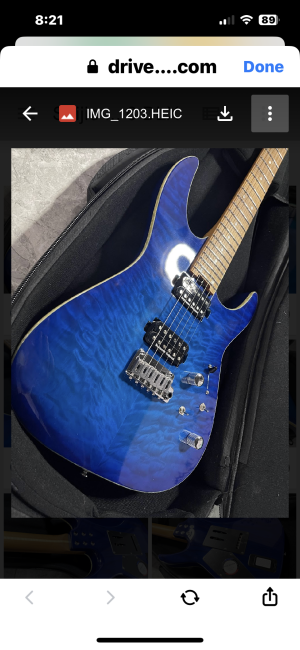
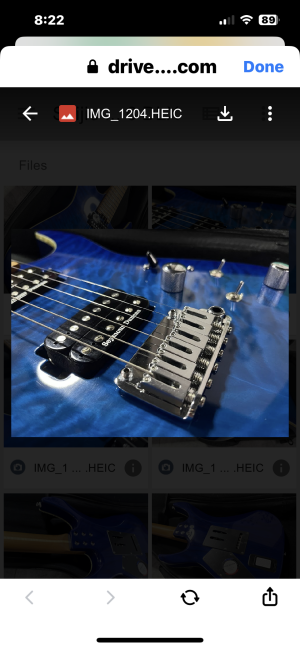
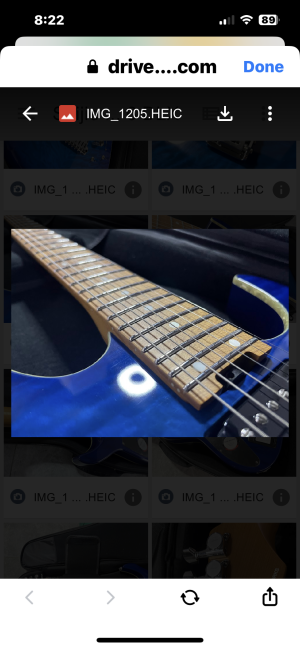
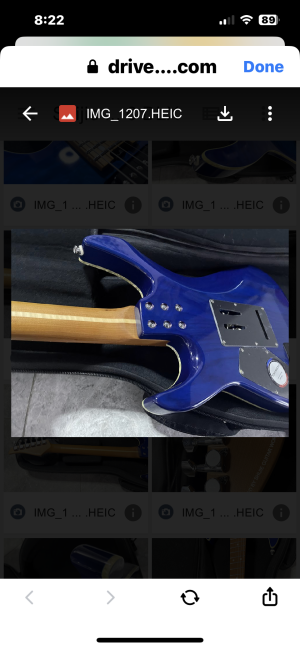
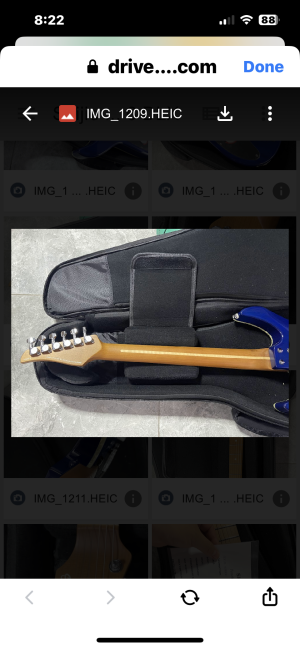
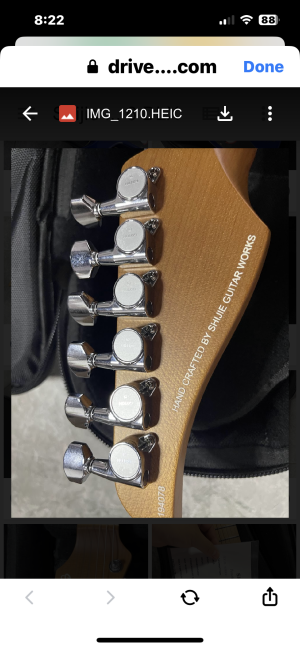
Some relevant background info, then the question—
I already know how to tweak a guitar’s setup with its existing string gauges. For example, I know how to adjust intonation, raise/lower saddles, adjust string height/action, adjust trem angle for more or less “pull up.”
However, I do NOT know the proper order of setup for a guitar when going from heavy to light gauge strings, because it’s not a “minor tweak.”
Ok, having said all THAT….
Eagle, the following guitar comes to you for a setup:
A Super Strat, 2 humbucker guitar
(Duncan Jazz/JB pickup set)
Roasted Maple, 24 stainless steel
frets, bolt-on neck
12” radius
Non-locking tuners
Gotoh 510 trem, 3 trem springs \ I /
Bone nut
Strung with 10-46 gauge strings
(.010 .013 .017 .026 .036 .046)
Standard tuning E
(String tension calculator says 111.5 lbs tension)
The owner (me of course,) wants to put the following gauge of strings on it: 008 .011 .014 .022 .032 .046
(String tension calculator says 75.8 lbs tension. I MUST use this low tension because of tendon problems)
I want the lowest possible string action, and the ability for the trem to pull-up as well as go down in pitch.
I want the neck relief to be as close to zero as possible.
So Eagle, could you list the steps as succinctly (or detailed if you want,) for the setup of my new guitar?
For example:
1. Remove strings
2. Wait 24 hours for neck to adjust to lack of tension
3. Restring, tune up to pitch
4. Measure relief
5. Adjust truss rod relief to zero
6. Adjust claw tension
7. Adjust saddle height
8. Retune
9. Intonate
Etc.
Thank you sincerely for any help!
If it helps, pics of the guitar:






Last edited:
You are along the right lines . I personally don’t think that you need to remove the strings for a day . You are wanting the guitar to get accustomed to lower tension so going to no tension first won’t help. Put on the strings ( no wait) balance the trem and the set the relief. You will be very unlucky or have a semi dysfunctional truss rod to need to readjust over the next couple of days. I expect you will be close to no tension anyway. After that setup as you normally would.
James Freeman
Rock Star
- Messages
- 4,299
Andy, what are the main points in a guitar that allow for a good low action with well resonating strings with minimal fret buzz in the upper part of the guitar?
I do the exact same setup on my Cort X-TH and American Strat, they are worlds apart in terms of sustain, resonance, and fret buzz.
One is all mahogany neck-through and the other is... well a Fender.
I do the exact same setup on my Cort X-TH and American Strat, they are worlds apart in terms of sustain, resonance, and fret buzz.
One is all mahogany neck-through and the other is... well a Fender.
The relief is super important . Even a hair of fall away cut in to 12 to the end. The relief needs to be the minimum that works. Typically that is half the thickness of your high E at fret 7 when you fret the G at 1 and 12( using the G at your straight edge reference.)Andy, what are the main points in a guitar that allow for a good low action with well resonating strings with minimal fret buzz in the upper part of the guitar?
I do the exact same setup on my Cort X-TH and American Strat, they are worlds apart in terms of sustain, resonance, and fret buzz.
One is all mahogany neck-through and the other is... well a Fender.
Then fret 12 to the end , this should be dead flat. Frets need to be level. Set your action in relation to the frets and don’t use radius gauges.
Also never judge the relief with the guitar on a bench and particularly not using a neck cradle. In playing position.
laxu
Rock Star
- Messages
- 8,372
Andy, what's your strategy for setting action for different clients who might request different things based on their preferences? How do you figure out what the client wants when they are probably explaining it in poor terms?
Since I only set up guitars for myself, I don't really bother being very scientific about it like measuring precisely etc. I set the strings to follow the radius using a radius gauge but otherwise tend to adjust the string heights until it feels right to me - as an example a "metal" guitar might be set for low action because it's more likely that I will play fast notes and riffs on it whereas something like a Strat will be more often a blues guitar so I set it up based on how it feels for bends. When it feels right, I know it.
Since I only set up guitars for myself, I don't really bother being very scientific about it like measuring precisely etc. I set the strings to follow the radius using a radius gauge but otherwise tend to adjust the string heights until it feels right to me - as an example a "metal" guitar might be set for low action because it's more likely that I will play fast notes and riffs on it whereas something like a Strat will be more often a blues guitar so I set it up based on how it feels for bends. When it feels right, I know it.
I do different levels of setup for different people. Most people are happy to trust me to optimise the setup for the string type and the instrument in question. This takes in to account the limitations of a particular design.Andy, what's your strategy for setting action for different clients who might request different things based on their preferences? How do you figure out what the client wants when they are probably explaining it in poor terms?
Since I only set up guitars for myself, I don't really bother being very scientific about it like measuring precisely etc. I set the strings to follow the radius using a radius gauge but otherwise tend to adjust the string heights until it feels right to me - as an example a "metal" guitar might be set for low action because it's more likely that I will play fast notes and riffs on it whereas something like a Strat will be more often a blues guitar so I set it up based on how it feels for bends. When it feels right, I know it.
With a lot of my professional clients I set up an appointment and sit with them playing and telling me what they are hoping to get out of the guitar. If the guitar has nothing fundamentally wrong with it other then set up I can do that during the appointment. This allows me to see what they play like and try different things with immediate feedback.
I can demonstrate that when you get to a functional medium low action lowering it more may take more than you gain . For example a high E set a 50/1000” is not really harder to play than one at a 40/1000” but the dynamic range is less and the ceiling limit on the strings is compromised. The effects of fret hight on set up options comes in to play at this point. The grip you require on a string to articulate a note easily starts to go with a combination of lower fret and lower action. I can get them to feel it and see the reaction.
The big thing that is almost always wrong is relief and the effects that has on playability on the upper half of a curve radius means it the neck is functioning properly I can usually transform the performance . Often people come wanting the lowest action and easiest player possible and they end up finding that doesn’t necessarily work for their pick technique.
One thing I would mention is radius gauges are not a good way of setting action. Set every string to a number in a noted reference point.
Yes set up is about feel but this is on top of a correctly functioning core setup .
Over the years I have sat in with many pro players ( quite a few you would know) and often they have setups that don’t work best for their requirements and by the end of the time they are arranging to send me every guitar they own.
To keep a guitar setup tuned to this point is difficult if you don’t do it yourself because temperature string changes/ anything effects it. And all this is on top of perfect frets and an ‘ideal’ relief architecture . Of all the repairs and work I do this and refrets are the most important things.
laxu
Rock Star
- Messages
- 8,372
I mainly use radius gauges to get the strings to an approximate curvature of the fretboard after I feel the action is already in about the right place. Is this the wrong approach?One thing I would mention is radius gauges are not a good way of setting action. Set every string to a number in a noted reference point.
I would say so because the measurement that matters is the action. It is pretty easy to gradually increase the action across the strings with a action gauge and the radius will match better even on a compound radius.I mainly use radius gauges to get the strings to an approximate curvature of the fretboard after I feel the action is already in about the right place. Is this the wrong approach?
Most TOMs are angled because they don’t have enough adjustment to be straight but wide ones can be. I prefer the tone of an ARB1 but the wire can be a PITA to get to press all the saddles on versions that have it. On a Les Paul I think minimalist hardware sounds best.Hello Andy, was wondering why some TOM are straight and some are angled ? any reasons or purpose ??
Also any advantages disadvantages to ABR 1 or Nashville type bridge ?
Thanks
Original versions of both are zinc and that can fail over time. There’s plenty of bent examples of each . Callaham makes a milled steel abr1 but it is a bit bright for me so I prefer the original without the wire.
